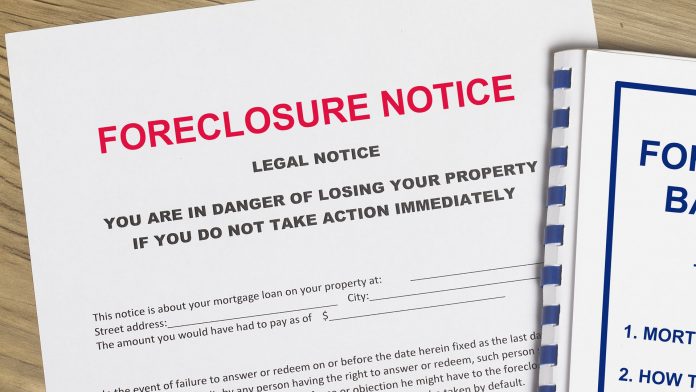Key Highlights
- Bankrate offers us definitions and processes involved with home foreclosure
- Bankrate spells out five steps of foreclosure
Housing market experts, economists, elected officials at all levels of government, lenders and individual homeowners all share the same worry in light of CARES Act relief packages poised to expire at the end of this month…home foreclosure.
During the 2008-2009 Housing and Financial Crisis, some 10M homeowners lost their homes to foreclosure. This current COVID-19 pandemic crisis has the potential of dwarfing those 2009 numbers at least twofold as experts are predicting that some 20M – 28M homeowners may lose their homes to foreclosure over the next few months.
Time for everyone involved with real estate to, at the very least, bone up on the definitions and processes of foreclosure. Bankrate is helping us understand the processes and definitions of foreclosure. Here we go.
Download Your FREE Ultimate Agent Survival Guide Now. This is the exact ‘do this now’ info you need. Learn NOW How to Access All The Bailout Program Cash You Deserve. Including Unemployment and Mortgage Forbearance Plans. To Access the Ultimate Agent Survival Guide Now Text The Word SURVIVAL to 47372. 4 Msgs/Month. Reply STOP to cancel, HELP for help. Msg&data rates may apply. Terms & privacy: slkt.io/JWQt
First of all, what is a foreclosure?
- A foreclosure is when a lender takes over the control of a property after the borrower misses several payments on the mortgage loan.
- When buying a home, most buyers don’t have enough money to buy the home outright for the full purchase price of the home. Most buyers put down a down payment (a percentage of the purchase price) to “obtain” the house and then most likely make a deal with a lender to get a loan to pay for the balance of that purchase price.
- The lender finances the loan and essentially owns that house until the buyer pays back the lender for the balance on that loan. So, the buyer becomes a borrower and that borrower agrees to pay back the lender a specific amount every month for a set number of years (called a monthly mortgage payment) in order to pay back the lender for the loan the lender gave them in order to buy the house.
- If/when the buyer/borrower fails to make those monthly mortgage payments on that loan, the lender can then take control of the property and sell it as a way to make up for the funds the homeowner didn’t pay
How do foreclosures work?
- If the borrower does not pay or “falls behind” on the monthly mortgage payment(s), the lender can begin the foreclosure process
- The foreclosure process can be either
- Judicial foreclosure whereby the lender gets a court order
- Non judicial foreclosure depending on where (which state) the property is located
Step 1: Missed Mortgage Payments
- If the borrower misses the mortgage payment by just a few days, it’ll likely be okay because the lender MAY (not must) have a grace period of up to two weeks in which to make a payment. (Grace periods vary by state.)
- If the borrower doesn’t make a payment within that grace period, the mortgage payment is now late and there will be late fees on top of the “regular” payment.
- The lender will no doubt be in touch with the borrower when the mortgage payment is considered to be late.
Step 2: Notice of Default
The lender will file a Notice of Default with the county’s recorder office AND will send the borrower that Notice of Default either by certified mail or by posting it one the borrower’s front door.
- That Notice of Default will stipulate how much the borrower owes and need to pay the lender in order to bring the mortgage back into good standing.
Step 3: Pre-Foreclosure
- This is the time between the Notice of Default and the auction/sale of the house to pay off the loan debt owned to the lender.
- The amount of time between getting the Notice of Default and having to auction or sell the house to pay off the lender varies by state.
- A Short Sale may happen during this time period as a Short Sale is when the borrower is able to sell the house in order to pay back the amount owed to the lender.
Step 4: Notice of Sale
- If the borrower hasn’t the money to “bring back the mortgage into good standing” by paying the lender the amount owed on the missed mortgage payments, the lender then files a public information Notice of Sale on the house. The house will then be sold at auction at a specified time and location
- How a Notice of Sale is published as public information depends on the state. Some states will post the Notice of Sale on the property itself, in a local newspaper, on the door of a local courthouse, etc.
- Because that Notice of Sale is often published in multiple places on multiple venues, several buyers may become interested in buying the house. Any money gleaned from that auction or sale goes to the lender.
Step 5: Eviction
- The borrower will have a few days (again, it varies by state) to vacate the house and find a different place to live. Borrowers are allowed to take their personal belongings with them.
Make sure you tell your clients who may miss (or missed) a mortgage payment to talk with their lender upfront. Lenders do, in fact, notice when borrowers miss mortgage payments. Lenders may be able to help.
According to Tom Goyda, senior vice president of Consumer Lending Communications at Wells Fargo, “We need to talk with (borrowers) directly to understand their circumstances and identify the best way to help them. The earlier we can start to work with them, the better…For customers who contact us, we won’t report suspended payments as past-due to the consumer reporting agencies or charge late fees for payments not made during the suspension period. And we won’t foreclose on any customer who is in forbearance.”
Tell your clients…the federal government extended the foreclosure moratorium until at least August 31, 2020, to accommodate borrowers impacted by the COVID pandemic.
Know that the US Senate and House of Representatives is in the midst of negotiations concerning new relief packages for people impacted by the COVID pandemic. Watch this space for ongoing updates on enhanced unemployment insurance benefits, forbearance, eviction moratoriums, etc.
Thanks to Bankrate.
Also read: Purchase Applications WAY Up – Interest Rates WAY Down, How Old is Too Old for a 30-Year Mortgage?, Why It’s Now Harder to Get a Mortgage/Refinance
























